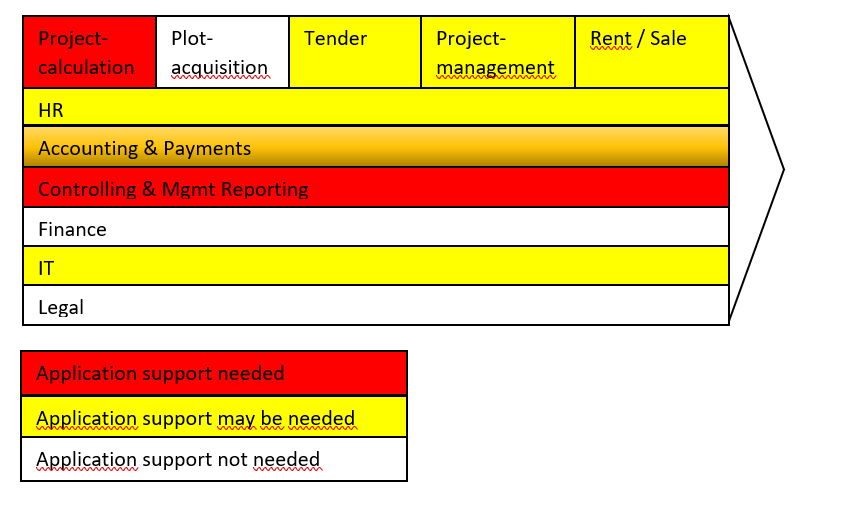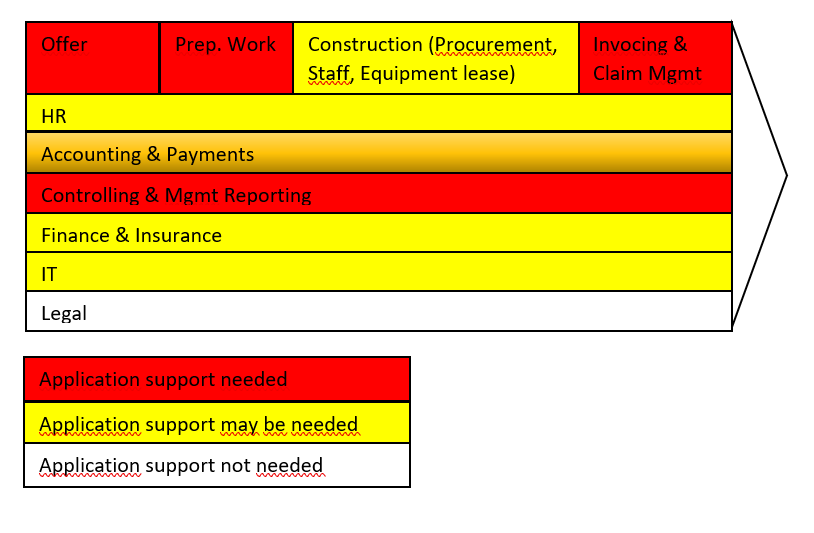Digitalization is one of the most important developments of recent years. Construction and real estate industries have been lagging behind other industries for years. One of the biggest hurdles on the way to digitizing a company is the interfaces between different tools. The application landscape of many construction companies and enterprise developers resembles a patchwork carpet. Often, many isolated solutions have been bought together, which at some point someone in the company liked. Today, they cause a lot of effort due to multiple entries and prevent automated processes. I claim this does not have to be the case and go even further out on a limb with the following provocative thesis: "No construction or real estate company, regardless of its size, needs more than three product families to be integrated."
In order not to run the risk of losing a possible bet, I would like to add a small disclaimer: specialized product add-ons from third-party companies count as part of the same product family as the base product (since the provider takes care of the necessary updates here) and pure (web) solutions without connectivity requirements do not count as applications.
How do I come to such a bold statement?
The following diagram gives an overview of the processes of real estate developers and their need for application support:

Every real estate developer needs a calculation and controlling tool (which may well be self-made); depending on the size and degree of outsourcing, there may be additional application requirements. A special position is occupied by accounting, which may be outsourced, especially in the case of smaller developers. Nevertheless, data for project costing and controlling is definitely needed on a regular basis, so this should be considered when designing the application landscape.
To back up my claim, I'll now briefly change my perspective and define Microsoft as set. Life without Excel, PP and Word is simply unthinkable nowadays.
Conversely, by using the Microsoft product family, calculation and controlling (Excel), IT processes (e.g. Intune for device management) and also workflows (Automate) can be mapped, as well as storage using Sharepoint and Onedrive.
For smaller developers, tender and project management can also be well mapped by using Microsoft products (Word, Outlook and especially MS Project), at best with the addition of a web solution for defect management that need not be integrated.
I do not see a good representation of the needs of real estate developers through the Microsoft product range with regard to payroll accounting, accounting and marketing/CRM. The extent to which a CRM is needed must be critically questioned on a case-by-case basis, but it cannot be ruled out even for "smaller" developers who, for example, are developing a project with 100 residential units.
If a smaller developer does not need a CRM and payroll and accounting are run by the tax consultant, then a pure Microsoft approach is quite target-oriented. In this case, however, it is important to clearly define and implement the process and tool-side interface to the tax consultant's tool (usually BMD).
If payroll accounting and bookkeeping are not outsourced and a CRM is actually required, the applications purchased for this purpose represent numbers 2 and 3.
A possible such combination would be e.g. Microsoft, BMD and Salesforce.
For larger developers, accounting/payroll/payment, CRM, and any other HR needs (recruiting, scheduling, etc.) can be mapped to SAP, so theoretically everything is already covered with SAP and Microsoft. To be fair to large developers, the question arises whether a professional integrated project costing and planning solution (instead of Excel) would not be appropriate. The selection of such a large-scale project costing and planning solution is a science in itself. Nevertheless, more than 3 product families will not do.
Let us now turn to the construction business. The following graphics again provide an overview of processes and their need for application support:

Due to the low margins and the high time pressure, I consider tool support across almost all phases of the core performance process and also for ongoing controlling to be absolutely essential for construction companies of all sizes. Depending on the size of the construction company, there is also a need in the fields of construction project management, HR, financing (guarantees) and IT.
For the analysis we change the perspective again. Microsoft is also a must for a construction company, which means that at least IT processes, workflows, filing and project schedule management are covered. Whether bid calculation and submission, tendering, awarding and invoicing can also be done in the Microsoft world depends heavily on the size of the construction company. In contrast to real estate developers, where a professional calculation tool is only necessary for very large players, smaller construction companies certainly already reach their limits here.
For small construction companies that have their accounting run by their tax advisor and do not need any guarantee management, a pure Microsoft approach is therefore also conceivable here.
If the accounting system is run by the company itself, the areas of accounting, payroll, payment and guarantees are covered by the ERP application. The previously mentioned AVA tool for the areas of bid calculation and submission, tendering, awarding and invoicing would be the third in the group.
Unlike a smaller real estate developer, the CRM issue is not virulent in a smaller construction company. 10-20 customers and quite possibly a multiple of potential prospects can be managed in MS Outlook. When choosing an ERP system for a larger company, it is important to ensure that it also covers the CRM topic in addition to accounting and controlling.
Two possible tool combinations that cover the entire needs of a construction company are e.g. Auer/BMD/Microsoft or iTwo/SAP/Microsoft.
At this point, I don't want to give the impression that digitizing the construction and real estate industry is easy. Defining the processes across multiple tools (e.g., master data maintenance) is not easy, nor is programming the interfaces. The latter especially in light of the fact that some application vendors are not particularly open-minded in this regard.
I also do not want the above product combinations to be understood as unconditional recommendations. Which tools are the right ones for a company can only be said after an appropriate analysis. What can definitely be said, however, is that the digitization of a company is doomed to failure if there is a corresponding proliferation of systems. And that construction companies and developers of all sizes can be provided with 3 product families in terms of processes.






To the gregor-pfeiffer.at owner, Your posts are always well-supported by research and data.
Hi gregor-pfeiffer.at owner, Keep up the good work!
To the gregor-pfeiffer.at admin, Your posts are always well written and informative.
Hello gregor-pfeiffer.at admin, You always provide great examples and real-world applications.
Hello gregor-pfeiffer.at webmaster, You always provide great resources and references.
Dear gregor-pfeiffer.at admin, Your posts are always well written and informative.
vpn for firestick free free vpn trial opera free vpn https://ippowervpn.net/
vpn for firestick free free vpn trial opera free vpn hotspot shield vpn proxy free
vpn buy free vpn for roobet vpn for firefox the best vpn for windows
buy hidemyass vpn best free vpn windows 10 buy dedicated vpn https://imfreevpn.net/
buy hidemyass vpn best free vpn windows 10 buy dedicated vpn anonymous vpn
buy vpn router best vpn service for mac hotspot vpn free https://superfreevpn.net/
buy vpn router best vpn service for mac hotspot vpn free vpn for firefox
best budget vpn google vpn free vpn free mac https://rsvpnorthvalley.com/
best budget vpn google vpn free vpn free mac vpn free trial no credit card
best vpn service for mac best torrenting vpn setupvpn – lifetime free vpn https://shiva-vpn.com/
best vpn service for mac best torrenting vpn setupvpn –
lifetime free vpn vpn free for pc
proton free vpn free russian vpn whats the best vpn https://freehostingvpn.com/
proton free vpn free russian vpn whats the best vpn what is vpn?
best vpn canada vpn routers best buy best vpn for windows free https://freevpnconnection.com/
best vpn canada vpn routers best buy best vpn for windows free surfshark vpn
avast vpn free trial best vpn to use in china zenmate vpn https://bordervpn.com/
avast vpn free trial best vpn to use in china zenmate vpn what is the best free vpn
buy pia vpn best vpn service for mac best vpn proxy betternet https://govtvpn.com/
buy pia vpn best vpn service for mac best vpn proxy betternet proton vpn download
express vpn free trial best free vpn windows 10 best free vpn for laptop https://courtvpn.com/
express vpn free trial best free vpn windows 10 best free vpn for
laptop best vpn for roku
Dear gregor-pfeiffer.at owner, Your posts are always well-written and easy to understand.
Hi gregor-pfeiffer.at administrator, You always provide in-depth analysis and understanding.
Hello gregor-pfeiffer.at owner, You always provide clear explanations and step-by-step instructions.
Hello gregor-pfeiffer.at admin, Thanks for sharing your thoughts!
Hi gregor-pfeiffer.at webmaster, You always provide helpful diagrams and illustrations.
To the gregor-pfeiffer.at webmaster, Thanks for the educational content!
To the gregor-pfeiffer.at webmaster, Your posts are always well-referenced and credible.
To the gregor-pfeiffer.at administrator, You always provide helpful diagrams and illustrations.
To the gregor-pfeiffer.at owner, Thanks for the informative post!
Hello gregor-pfeiffer.at webmaster, Your posts are always well organized and easy to understand.
essays writing help essay on service essay writing help online https://essay-writing-helper.com/
essays writing help essay on service essay writing help online cheapest custom essays
Hi gregor-pfeiffer.at owner, Thanks for the comprehensive post!
Dear gregor-pfeiffer.at admin, Great content!
To the gregor-pfeiffer.at administrator, Keep the good content coming!
To the gregor-pfeiffer.at owner, You always provide clear explanations and step-by-step instructions.
Hello gregor-pfeiffer.at owner, You always provide clear explanations and definitions.
Hi gregor-pfeiffer.at admin, You always provide practical solutions and recommendations.
Hi gregor-pfeiffer.at webmaster, Your posts are always a great source of information.
Hello gregor-pfeiffer.at webmaster, Your posts are always well organized and easy to understand.
Dear gregor-pfeiffer.at administrator, You always provide useful links and resources.
To the gregor-pfeiffer.at webmaster, Your posts are always well-supported by facts and figures.
Hello gregor-pfeiffer.at administrator, Thanks for the valuable information!
Hi gregor-pfeiffer.at owner, Your posts are always well written and informative.
Hi gregor-pfeiffer.at owner, You always provide in-depth analysis and understanding.
Hi gregor-pfeiffer.at administrator, Your posts are always well researched and well written.
To the gregor-pfeiffer.at owner, Good to see your posts!
Dear gregor-pfeiffer.at webmaster, Your posts are always well-referenced and credible.
Dear gregor-pfeiffer.at webmaster, Your posts are always a great source of information.
Dear gregor-pfeiffer.at webmaster, You always provide practical solutions and recommendations.
To the gregor-pfeiffer.at owner, Thanks for the well-structured and well-presented post!
To the gregor-pfeiffer.at webmaster, You always provide in-depth analysis and understanding.
Hi gregor-pfeiffer.at admin, Keep up the great work!
To the gregor-pfeiffer.at webmaster, Keep up the great work!
Hi gregor-pfeiffer.at webmaster, Thanks for the well-organized and comprehensive post!
Hello gregor-pfeiffer.at admin, Your posts are always well-referenced and credible.
%random_anchor_text% %random_anchor_text% %random_anchor_text% https://customessaywwriting.com/
%random_anchor_text% %random_anchor_text% %random_anchor_text% .
essay on service to humanity buy essay online safe essay about
helping others https://besteasyessays.org/
essay on service to humanity buy essay online safe essay about helping others help writing an essay
Hi gregor-pfeiffer.at owner, You always provide great examples and case studies.
Hello gregor-pfeiffer.at administrator, You always provide practical solutions and recommendations.
Hello gregor-pfeiffer.at admin, Your posts are always well-written and easy to understand.
Dear gregor-pfeiffer.at admin, You always provide practical solutions and recommendations.
To the gregor-pfeiffer.at owner, Thanks for the well-organized and comprehensive post!
Hi gregor-pfeiffer.at webmaster, You always provide valuable information.
Hello gregor-pfeiffer.at admin, Thanks for the informative and well-written post!
Hi gregor-pfeiffer.at admin, Thanks for the in-depth post!
Dear gregor-pfeiffer.at admin, Good job!
adult dating sites dating online online dating service https://freewebdating.net/
adult dating sites dating online online dating
service freewebdating.net
all free dating site connecting singles online members
adult dating sites https://onlinedatingsurvey.com/
all free dating site connecting singles online members adult dating sites dating website free
best dating websites free online marriage sites in usa online dating service https://jewish-dating-online.net/
best dating websites free online marriage sites in usa online dating service connecting singles
good free dating sites good free dating sites singles dating https://onlinedatinghunks.com/
good free dating sites good free dating sites singles dating local personal ads
Dear gregor-pfeiffer.at webmaster, Keep up the great work!
Hello gregor-pfeiffer.at admin, Thanks for the great post!
To the gregor-pfeiffer.at owner, Thanks for the well-researched and well-written post!
Hi gregor-pfeiffer.at webmaster, Thanks for the well written post!
Hi gregor-pfeiffer.at webmaster, Thanks for the well written post!
To the gregor-pfeiffer.at admin, Your posts are always a great source of information.
To the gregor-pfeiffer.at owner, Your posts are always informative and well-explained.
To the gregor-pfeiffer.at webmaster, You always provide in-depth analysis and understanding.
Hello gregor-pfeiffer.at owner, Your posts are always thought-provoking and inspiring.
coursework b science titles coursework grade boundaries coursework in or on https://buycoursework.org/
coursework b science titles coursework grade boundaries coursework in or on courseworks help
custom coursework writing service king’s college london coursework coursework spelling https://brainycoursework.com/
custom coursework writing service king’s college london coursework coursework spelling brainycoursework.com
coursework for masters degree coursework translate coursework
definition https://writingacoursework.com/
coursework for masters degree coursework translate coursework definition coursework vs thesis masters
coursework project coursework cambridge coursework writer https://teachingcoursework.com/
coursework project coursework cambridge coursework writer nursing coursework
coursework hours differential equations coursework coursework in korean https://courseworkinfotest.com/
coursework hours differential equations coursework coursework in korean coursework phd
Hello gregor-pfeiffer.at admin, Thanks for the comprehensive post!
coursework report example coursework advantages and disadvantages coursework jelentése https://coursework-expert.com/
coursework report example coursework advantages and disadvantages coursework jelentése coursework definition
coursework plan quantitative coursework examples coursework job meaning https://mycourseworkhelp.net/
coursework plan quantitative coursework examples coursework job meaning coursework topics
coursework support differential equations coursework coursework research https://courseworkdomau.com/
coursework support differential equations coursework coursework research coursework define
Dear gregor-pfeiffer.at admin, Thanks for the in-depth post!
coursework advantages and disadvantages coursework in korean coursework for high school https://courseworkninja.com/
coursework advantages and disadvantages coursework in korean coursework for high school coursework masters